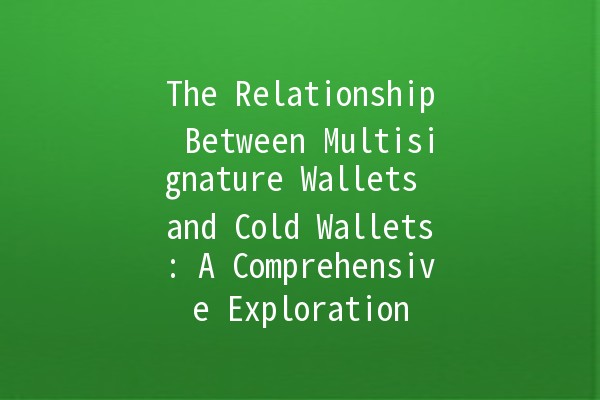




In the world of cryptocurrencies, safeguarding assets is paramount. Among various wallet types, multisignature wallets (multisig wallets) and cold wallets are two popular choices, each offering unique security features. Understanding their relationship not only enhances your knowledge but also aids in determining the most suitable wallet for your needs.
A multisignature wallet is a type of cryptocurrency wallet that requires multiple private keys to authorize a transaction. This approach enhances security by distributing access and control over the funds. The wallet can be configured to require a predefined number of signatures (e.g., 2of3) from different keys to execute transactions, making it significantly more challenging for unauthorized parties to access the funds.

A cold wallet, on the other hand, refers to any cryptocurrency wallet that is not connected to the internet. This includes hardware wallets, paper wallets, and airgapped computers. The primary purpose of cold wallets is to provide maximum security against online threats such as hacks and phishing attempts.
While multisignature wallets and cold wallets serve distinct purposes in the cryptocurrency world, they can be combined for enhanced security. A multisignature cold wallet incorporates the security features of both types of wallets, offering users the best of both worlds.
To better understand how multisig and cold wallets work in harmony, let’s explore practical applications.
A corporation can set up a multisig cold wallet requiring signatures from the finance department head, the legal department, and an external auditor. This setup not only secures the funds from unauthorized access but also promotes accountability and transparency within financial operations.
A family could employ a multisig cold wallet to manage shared assets, requiring signatures from multiple family members before any transactions are performed. This feature promotes family discussions on expenditure and investment, enhancing financial literacy among family members.
Explanation: Conduct regular audits of your multisig and cold wallet configurations.
Application: Schedule biannual reviews to ensure all signatures and access controls are up to date, reducing potential vulnerability windows.
Explanation: Implement a comprehensive token backup strategy.
Application: Store keys for your multisig wallet in multiple secure locations, such as a safe deposit box or a secure digital vault.
Explanation: Educate all participants on wallet usage and security protocols.
Application: Host workshops to explain how to interact with both multisig and cold wallets securely, fostering responsible management of digital assets.
Explanation: Utilize smart contracts to automate parts of the transaction approval process.
Application: Develop a smart contract that automatically triggers certain actions upon receiving the required number of signatures within a specified time frame.
Explanation: Keep your cold wallet hardware's firmware updated.
Application: Subscribe to notifications from wallet manufacturers to ensure you are aware of any important updates or patches.
A multisignature wallet requires multiple signatures from different keys to authorize a transaction, unlike traditional wallets that rely solely on a single private key. This means that even if one key is compromised, the funds remain secure as the attacker would need additional keys to access the wallet.
While cold wallets offer superior security compared to online wallets by being offline, they are not immune to all risks. Physical damage, theft, or loss of the wallet can occur. Therefore, users should implement backup strategies and keep the wallets in secure locations.
Yes, multisignature configurations can be employed with various types of wallets, including software, hardware, and cold wallets. The implementation can differ based on the wallet type and the service provider.
Consider your security needs, the level of control required, and how often you plan to access the funds. If security is your top priority and you do not need constant access, a multisig cold wallet may be the best option.
Setting up a multisignature cold wallet typically requires selecting a multisignature wallet service that supports cold storage, defining the number of required signatures, and securely generating and storing private keys. You may also need hardware wallets that hold these keys.
Costs can vary widely based on the services and hardware chosen. Multisig wallet setups may incur service fees, while cold wallets may involve the initial purchase price of the hardware and any ongoing maintenance or security protocol costs.
As we explore the dynamic between multisignature wallets and cold wallets, we encourage you to reflect on your own cryptocurrency storage strategies. Engaging in discussions with peers or seeking advice from financial experts can provide further insights into optimizing your asset safety. Stay informed, remain vigilant, and safeguard your digital assets effectively.
This exploration of multisignature and cold wallets showcases their crucial roles in securing assets. As you contemplate your strategies, remember that a wellinformed decision is your best defense against the evolving landscape of cybersecurity threats.